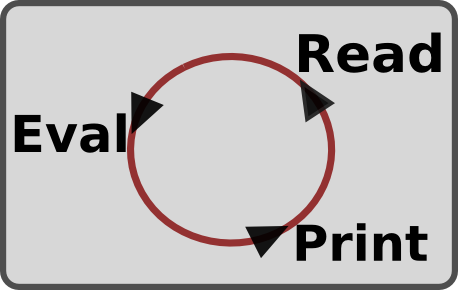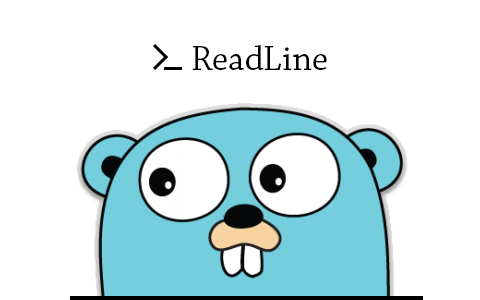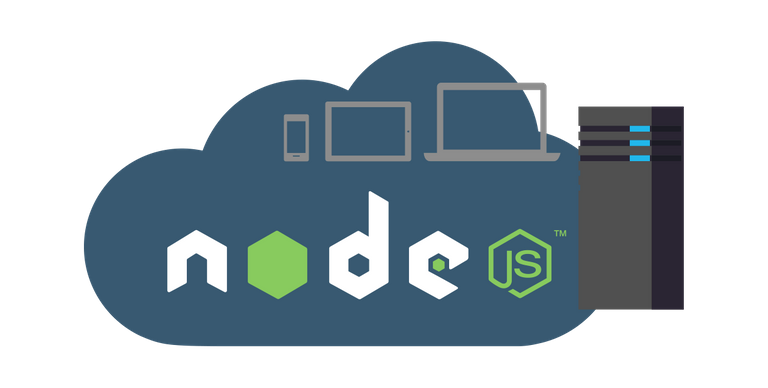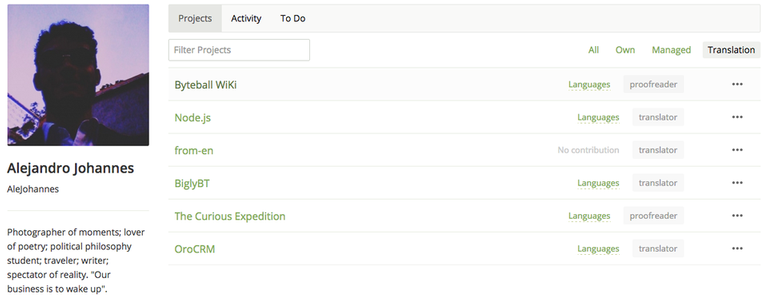Github Repository
https://github.com/nodejs/i18n
Project Details
By definition, Node.js is a Java Runtime Environment (JRE). But it is more than just that. While common JREs function as machine backups that allow users to smoothly run JavaScript on their browsers and applications, this open-source project functions as an app that manages Java code by itself. It's practical uses for developers are endless. It grants an extraordinarily versatile platform for designing code, programs, websites and other applications. And that isn't all: Node provides a virtual facility for testing the proper work of Java-driven programs and devices –and their planned updates–, helping to find bugs, solve errors, fix code and vastly improving their performance.
I believe all the amazing uses of Node are to be considered by themselves and I declare myself a fan of the project. But, besides, I support it for its functionality as a medium for bringing to reality countless creations that can be as good as Node itself. If you can dream it –and code it in JavaScript–, then your imagination is the only limit!The open translation of Node to thirty-three (33) languages proves the advantages of open-source projects when it comes to diversification of knowledge and worldwide spreading of useful tools.
Ahead, there is the link of the program's webpage:
Contribution Specifications
Translation Overview
This is my 36th contribution to Node.js as a translator. For this collaboration, I continued my previous work, on the repl.md file of Node.js' version 6, which, as its name indicates, contains the documentation of the REPL's implementation within the program, and began translating the readline.md of the same version of the program, containing the specifications of Node’s Readline module.
In my previous reports, I explained the consistence of REPL and its main uses for programs like Node.js. Here, I'll refer here an extract of said reports:
"This acronym stands for Read-Eval-Print-Loop. It is a simplistic, but very versatile, interactive programming environment. In it, users input information to a program through a console, this one reads it, evaluates it and returns determined expected results. REPL is specially useful for JavaScript, since is one of the command-line-alike programs that support the usage of scripts..."

For this collaboration, I’ll clarify the contents of the following string of the REPL document and explain what telnet and socat are, and how they affect the usage of Node.js’ REPL.

First of all, we need to set a definition for Telnet and... DING, DING, DING!… I have it! Telnet stands for Telecommunication Network and it is a network protocol that allows and conducts the usage and management of computer machines from a remote distance. It was designed around 1983 and has gone through several adaptations and in-program implementations, due to its security vulnerabilities. Now, it might not see like a big deal… But trust me… When it came out and people saw their machines being used by a person that wasn’t in the room, they were all like…

Following that, we can define Socat. It is a bidirectional data transfer utility. Why is it helpful when we use Node’s REPL? Because it transfers said data with streams and uses a command line as its interface. Socat allows multiple specifications and in-app options setting and configuration, making it a great platform for REPL streaming customization.
We decided to interview Socat for this report, and this is what it said:

–Yes, Socat… You certainly are! 👍
What Node specifies here about these couple tools is that each of them comes quite handy when we deal with different types of sockets and respond to their specific features, like keys to their respective padlocks. In the case of the Transmission Control Protocol (TCP) sockets, Telnet is a useful resource, most certainly because of the security implications of the operations implying them. On the other hand, when we are about to go on Unix sockets in the transferring of our data, we should use Socat.

Beginning with the explanations of the new file I started translating, I’ll talk about what Readline is and why is it useful. In JavaScript, Readline is a method that performs data streams reading line by line. When dealing with streams, users would get confused and unable to perform specific target operations within great chunks of data if developers wouldn’t have thought about methods that direct them to their main goals, ignoring the rest of the contents of said aggrupation of digital information. Readline comes particularly useful at that point, when users want to parse particular parts of data and make operations just with those. In simple words, Readline simplifies the work of programmers… Big time!

You can check more about the aforementioned concepts here:
- https://searchnetworking.techtarget.com/definition/Telnet
- https://es.wikipedia.org/wiki/Telnet
- http://www.dest-unreach.org/socat/doc/socat.html
- https://www.linuxquestions.org/questions/linux-software-2/what-is-%27socat%27-and-what-is-it-used-for-ubuntu-15-04-a-4175554823/
- https://searchnetworking.techtarget.com/definition/TCP
- https://nodejs.org/api/readline.html
- https://www.quora.com/What-is-readline-function-in-JavaScript
Thanks for taking your time to read! Expect more information and tips on the next report :)


Work example #01:
English:
Previously in Node.js/io.js v2.x, REPL history was controlled by using a <0>NODE_REPL_HISTORY_FILE</0> environment variable, and the history was saved in JSON format.
Spanish:
Anteriormente, el historial del REPL en las versiones v2.x de Node.js e io.js era controlado mediante el uso de una variable de entorno <0>NODE_REPL_HISTORY_FILE</0>, y dicho historial era almacenado en formato JSON.
Work example #02:
English:
<0>Note</0> Once this code is invoked, the Node.js application will not
terminate until the <1>readline.Interface</1> is closed because the interface
waits for data to be received on the <1>input</1> stream.
Spanish:
<0>Nota:</0> Una vez que este código sea invocado, la aplicación Node.js no se dará por finalizada hasta que la <1>readline.Interface</1> se cierre, debido a que la interfaz espera a que se reciban datos en el stream de <1>input</1>.
Work example #03:
English:
If there are no <0>'SIGINT'</0> event listeners registered when the <0>input</0> stream receives a <0>SIGINT</0>, the <0>'pause'</0> event will be emitted.
Spanish:
Si no hay ningún listener del evento <0>'SIGINT'</0> registrado cuando el stream de <0>input</0> reciba un <0>SIGINT</0>, el evento <0>'pause'</0> será emitido.
Languages
This translation was made from English to Spanish.
I got plenty experience translating and proofreading this project as an Utopian contributor. I collaborate here as translator and Language Moderator of the Da-Vinci/Utopian Spanish translation team. Besides this project, I have experience translating and proofreading The Curious Expedition, Ancap-ch, Byteball Wiki, OroCrm and BiglyBT.
Word Count
- The amount of words translated in this contribution is: 1,222.
Note: This number is the result of subtracting the complete sum of non-translatable content to the word-count Crowdin has done for the period in which this contribution was done.
- The total amount of words translated in this project (as a Da-vinci/Utopian translator) is: 44,947.
Previous Translations of the Project
- Contribution N'01. Submitted on September 13th, 2018.
- Contribution N'02. Submitted on September 15th, 2018.
- Contribution N'03. Submitted on September 17th, 2018.
- Contribution N'04. Submitted on September 19th, 2018.
- Contribution N'05. Submitted on September 21th, 2018.
- Contribution N'06. Submitted on September 22th, 2018.
- Contribution N'07. Submitted on September 23th, 2018.
- Contribution N'08. Submitted on October 1st, 2018.
- Contribution N'09. Submitted on October 8th, 2018.
- Contribution N'10. Submitted on October 14th, 2018.
- Contribution N'11. Submitted on October 15th, 2018.
- Contribution N'12. Submitted on October 18th, 2018.
- Contribution N'13. Submitted on October 21st, 2018.
- Contribution N'14. Submitted on October 24th, 2018.
- Contribution N'15. Submitted on October 27th, 2018.
- Contribution N'16. Submitted on October 31th, 2018.
- Contribution N'17. Submitted on November 3rd, 2018.
- Contribution N'18. Submitted on November 4th, 2018.
- Contribution N'19. Submitted on November 6th, 2018.
- Contribution N'20. Submitted on November 17th, 2018.
- Contribution N'21. Submitted on November 24th, 2018.
- Contribution N'22. Submitted on December 7th, 2018.
- Contribution N'23. Submitted on December 15th, 2018.
- Contribution N'24. Submitted on December 20th, 2018.
- Contribution N'25. Submitted on December 26th, 2018.
- Contribution N'26. Submitted on December 28th, 2018.
- Contribution N'27. Submitted on December 30th, 2018.
- Contribution N'28. Submitted on January 9th, 2019.
- Contribution N'29. Submitted on January 10th, 2019.
- Contribution N'30. Submitted on January 12th, 2019.
- Contribution N'31. Submitted on January 18th, 2019.
- Contribution N'32. Submitted on January 19th, 2019.
- Contribution N'33. Submitted on January 24th, 2019.
- Contribution N'34. Submitted on January 28th, 2019.
- Contribution N’35. Submitted on January 31st, 2019.
Proof of Authorship
This translation was made between January 31st and February 27th. You can check the translation record in my Crowdin account [here], the activity on the project's Crowdin [here] and a summary of recent additions to the project [here].


Hi @alejohannes,
Thank you for submitting your contribution!
Node.js is a very interesting project that contains many code values and terms related to computer science. Its difficulty relies on the fact that we must pay a lot of attention to the code in order to deliver the most accurate translation possible.
Your presentation post is informative, provides useful and relevant information, as well as your personal feedback. The visual presentation of the post is also very good.
You shared clear and precise concepts you learned while working on this contribution in a very fun and dynamic way.
Your wording and spelling are correct and appropriate for the Spanish language and for the project.
Congratulations! :)
Your contribution has been evaluated according to Utopian policies and guidelines, as well as a predefined set of questions pertaining to the category.
To view those questions and the relevant answers related to your post, click here.
Chat with us on Discord
Thank you for your review, @marugy99! Keep up the good work!
Hi @alejohannes!
Your post was upvoted by @steem-ua, new Steem dApp, using UserAuthority for algorithmic post curation!
Your post is eligible for our upvote, thanks to our collaboration with @utopian-io!
Feel free to join our @steem-ua Discord server
Hey, @alejohannes!
Thanks for contributing on Utopian.
We’re already looking forward to your next contribution!
Get higher incentives and support Utopian.io!
Simply set @utopian.pay as a 5% (or higher) payout beneficiary on your contribution post (via SteemPlus or Steeditor).
Want to chat? Join us on Discord https://discord.gg/h52nFrV.
Vote for Utopian Witness!